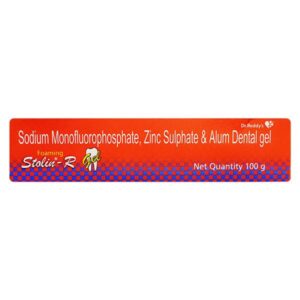ZINC + ALUMINIUM + DISODIUM MONOFLOURO PHOSPHATE
Zinc: Drug: Zinc
Use: Zinc is a dietary supplement that is used to treat or prevent zinc deficiency. It is also used to support the immune system, wound healing, and promote healthy growth and development.
Mechanism of Action: Zinc is an essential mineral that plays a vital role in various cellular processes in the body. It acts as a cofactor for numerous enzymatic reactions involved in DNA synthesis, RNA transcription, protein synthesis, and immune function. Zinc is also involved in antioxidant activity and helps maintain the structural integrity of proteins and cell membranes.
Dose: The recommended daily allowance (RDA) for zinc varies based on age and gender. For adults, the RDA ranges from 8-11 mg for males and 8-9 mg for females. Specific doses may vary depending on individual needs and health conditions. It is important to follow the recommended dosage instructed by a healthcare professional or as stated on the product label.
Side Effects: When taken in normal doses, zinc is generally safe for most individuals. However, side effects can occur, especially with excessive or prolonged use. The common side effects of zinc supplementation include nausea, vomiting, diarrhea, stomach cramps, and headaches. Long-term use of high doses of zinc can lead to copper deficiency, weakened immune function, and reduced levels of HDL (“good”) cholesterol. It is important to not exceed the recommended dosage without consulting a healthcare professional.
Additionally, zinc supplements can interact with certain medications, such as antibiotics and diuretics. Therefore, it is crucial to inform your doctor about any medications you are taking before starting zinc supplementation.
In rare cases, allergic reactions to zinc supplements may occur, resulting in symptoms like rash, itching, swelling, dizziness, or difficulty breathing. If these symptoms occur, immediate medical attention should be sought.
Disclaimer: The information provided here is for informational purposes only and should not be considered as medical advice. It is important to consult with a healthcare professional before starting any new medication or supplement.
Aluminium: Drug: Aluminium
Use: Aluminium is a medication primarily used as an antacid to relieve symptoms of heartburn, indigestion, gastroesophageal reflux disease (GERD), and stomach ulcers. It works by neutralizing excess stomach acid, providing temporary relief from these digestive issues.
Mechanism of Action: Aluminium compounds, such as aluminium hydroxide, act as a buffer by reacting with stomach acid to form aluminium chloride and water. This reaction effectively reduces the acidity in the stomach, providing relief from symptoms of hyperacidity. Additionally, aluminium compounds can form a protective layer on the stomach lining, helping to prevent further irritation and damage.
Dose: The dose of aluminium can vary depending on the specific product and the individual’s condition. It is typically taken orally in the form of tablets, capsules, or liquids. The dosage instructions provided on the package or as directed by a healthcare professional should be followed. It is important to note that aluminium should not be taken for prolonged periods without medical supervision.
Side Effects: While generally considered safe when used as directed, aluminium can cause some side effects. Common side effects of aluminium include constipation, diarrhea, stomach cramps, and nausea. If any of these side effects persist or worsen, it is important to consult a healthcare professional. In rare cases, long-term use of aluminium-containing antacids can lead to an excessive accumulation of aluminium in the body, resulting in symptoms such as bone pain, weakness, confusion, and seizures. It is important to take aluminium only as needed and under the guidance of a healthcare professional to minimize the risk of these potential side effects.
Disodium Monoflouro Phosphate: Disodium Monofluorophosphate, also known as MFP, is a chemical compound commonly used in dental products such as toothpaste and mouthwash for its dental-cavity preventing properties.
The primary use of Disodium Monofluorophosphate is for the prevention of tooth decay and cavities. It works by increasing the resistance of tooth enamel to acid attacks caused by bacteria in the mouth. MFP is actively incorporated into the hydroxyapatite crystals of tooth enamel, which makes the enamel more resistant to acid dissolution.
The recommended dose of Disodium Monofluorophosphate in toothpaste typically ranges from 1000 to 1500 parts per million (ppm). This concentration is considered safe and effective for daily dental hygiene.
While Disodium Monofluorophosphate is generally safe to use, some individuals may experience minor side effects. These side effects are usually mild and may include temporary tooth sensitivity or minor irritation of the gums and mouth. In rare cases, allergic reactions may occur, leading to symptoms like rash, itching, or swelling. If any severe side effects occur, it is essential to discontinue use and consult a healthcare professional.
It is important to note that Disodium Monofluorophosphate should not be swallowed in large amounts. It is meant to be used topically on the teeth and gums and rinsed out after brushing. Swallowing large quantities can lead to fluoride toxicity, which may cause symptoms such as nausea, vomiting, stomach pain, muscle weakness, or seizures. In extreme cases, it can be life-threatening.
Individuals with specific dental conditions such as tooth enamel defects or high fluoride levels in the drinking water should consult their dentist or healthcare provider before using products containing Disodium Monofluorophosphate.
Overall, Disodium Monofluorophosphate is a widely used dental compound that effectively contributes to the prevention of tooth decay and cavities when used in appropriate concentrations. It is important to follow the recommended dosage and guidelines to ensure its safe and effective use.

